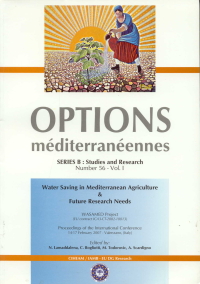| Article précédent | p. 293-302 | Article suivant |
Assessing adaptive capacity of large irrigation districts towards climate change and social change with irrigation management performance model
We developed a new physical model called Irrigation Management Performance Assessment Model (IMPAM) for assessing irrigation district's adaptive capacity towards climatic and social changes. It is a quasi three dimensional water balance model which represents the effects of irrigation, drainage canal networks and heterogeneous land use on agricultural production and water budget of the whole system. We applied the IMPAM to the Lower Seyhan Irrigation Project in Turkey and tested the district's adaptive capacity towards projected climate change in the 2070s. Due to the considerable decrease of precipitation in the winter time, the amount of irrigation demand is projected to increase (100-170mm) and the duration of irrigation to extend, from early spring to late autumn. Presently excessively high water table is projected to lower in the 2070s. Transition from gravity irrigation to drip irrigation in citrus gardens to adapt to water deficit would also enhance lowering of the water table. This study revealed that the problem of high water table was clearly the consequence of inefficient irrigation practice. For conserving adaptive capacity to possible climate change, it is strongly recommended that water use efficiency be improved in this district.
Nous avons développé un nouveau modèle physique appelé Modèle d'évaluation de la performance de la gestion de l'irrigation (IMPAM) afin d'évaluer la capacité d'adaptation d'une zone d'irrigation (le Bas-Seyhan, en Turquie) aux changements climatiques et sociaux prévus pour les années 2070. C'est un modèle quasiment tridimensionnel de bilan hydrique qui représente les effets de l'irrigation, les réseaux de canaux de drainage, l'hétérogénéité de l'utilisation des terres sur la production agricole et le budget eau de l'ensemble du système. Etant donnée la diminution considérable des précipitations en hiver, un accroissement de la demande d'irrigation (100-170mm) est prévue, qui s'étendra alors du début du printemps jusqu'à la fin de l'automne. Il est projeté que la nappe phréatique, actuellement excessivement haute, baisse vers 2070. La transition d'une irrigation gravitaire vers une irrigation en goutte à goutte dans les vergers d'agrumes permettrait de compenser le déficit et également d'abaisser le niveau de la nappe phréatique. Cette étude a mis en lumière le fait que le problème d'une nappe phréatique haute était clairement la conséquence d'une pratique d'irrigation inefficace. Pour préserver la capacité adaptative du système aux différentes évolutions et aux changements de climat, il est fortement recommandé que l'efficacité de l'utilisation de l'eau soit améliorée dans cette zone.
- [ Afficher ]
- [ Télécharger ]
- [ Exporter la citation ]
Vous pouvez télécharger la citation au format :
- [ Imprimer ]
-
Mots-clés
BILAN HYDRIQUE DU SOL, CHANGEMENT CLIMATIQUE, DRAINAGE, EFFICACITE, EVALUATION, GESTION DES EAUX, IRRIGATION, MODELE, TURQUIE, UTILISATION DE L'EAUCiter cet article
Nagano T., Hoshikawa K., Donma S., Kume T., Önder S., Özekici B., Kanber R., Watanabe T. Assessing adaptive capacity of large irrigation districts towards climate change and social change with irrigation management performance model. In : Lamaddalena N. (ed.), Bogliotti C. (ed.), Todorovic M. (ed.), Scardigno A. (ed.). Water saving in Mediterranean agriculture and future research needs [Vol. 1]. Bari : CIHEAM, 2007. p. 293-302. (Options Méditerranéennes : Série B. Etudes et Recherches; n. 56 Vol.I). Proceedings of the International Conference WASAMED Project (EU contract ICA3-CT-2002-10013), 2007/02/14-17, Valenzano (Italy). http://om.ciheam.org/om/pdf/b56_1/00800120.pdf



